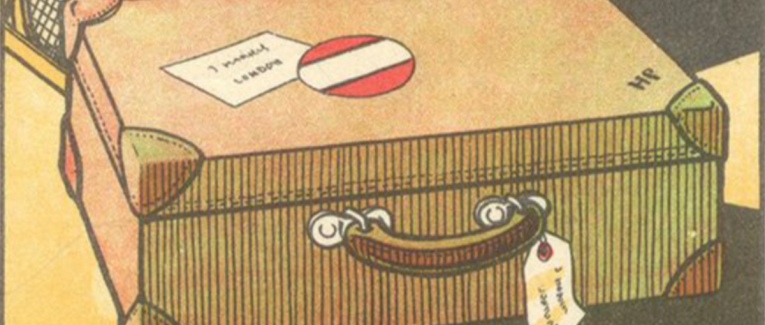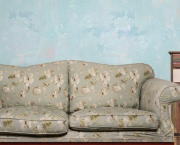
The transformations of a travel bag
 9 min
9 min
The transformations of a travel bag
I have a recurring nightmare: I’m rushing to catch a plane, bus, or train, and no matter how hard I try, I can’t make it. I never end up actually missing the ride but the rush to get there feels like it lasts a lifetime.
I’ve wondered more than once what this might mean. I usually have this dream when I’m trying hard to resolve something: to reach a career goal or buy a home, say, but due to my own limits or those of the bureaucratic apparatus, I feel stuck. I’ll also have this dream at times when I could actually miss a flight.
Which is why my trip to Switzerland, involving four connections, found me in a state of high anxiety. Better said, I was anxious but trying to hide it—a terrible habit that inevitably culminates in acid reflux. My only point of comfort was my suitcase, packed with everything dearest to me from home: the usual clothes, still smelling of fabric softener; 'come home soon' post-its and my favorite kind of oatmeal cookie.
The travel bag is both stability and endless freedom. That state in between belonging and alienation, either blissful or wretched, depending how you look at it, that you might experience in a non-place like Zurich airport, killing time as you wait for the train.
To quote György Lukács, the travel bag is an expression of transcendental homelessness. No surprise then that it should play such an important role in modern stories. It’s a symbol of transformation, forward movement and adventure, all in one. A prop for individual and collective tragedy. Orhan Pamuk's father, for example has a suitcase that tells the story of exile. Hana's baggage is a Holocaust story packaged for a young adult audience. For Updike's Rabbit, his trunk is an escape from adulthood. And Harry Potter often begins his adventures on an uncomfortable journey, brown travel bag by his side.
But back to Zurich, where I was waiting for the train to Lausanne. The very same Lausanne where Hemingway worked as a journalist at the age of twenty-three. One of the most famous travel bag mishaps in literature is linked to this city, in fact. Hemingway had asked his wife to bring his papers from Paris, so he could work on them during the holidays. But when Hadley stepped out for water at the Gare de Lyon, the luggage was stolen and with it, all of Hemingway’s writings up until then.
I should note that Hadley was traveling ill, and had taken on the exhausting journey with bags fit to burst. It couldn't have been easy to drag them with a high fever to the station and stay awake for the ten-hour ride. Take the man who pushed his red, hard-shell carry-on past me at the Zurich airport. How easy it was for him, even assuming he had a fever. His bag was fitted not just with two but four of those wheels that rotate at 360 degrees, enabling him to wheel his bag beside him as lightly as though it were a leaf.
That said, a few months before this trip I conducted a survey to see if four-wheel suitcases were feminine, since several of my man friends had told me they wouldn’t buy one for this very reason. Though the majority polled didn’t think four-wheelers were feminine, some still maintained they were unmanly. If it has two wheels, then all’s well. But four! Something’s clearly not right.
Watching this man, who couldn't have been more manly with his streamlined trainers, expensive leather belt and meticulously maintained beard, I was puzzled. Was the suitcase’s hard shell masculine enough to make up for the femininity of the four wheels? Or had the man been graced with enough self-confidence to shuck off these sorts of social expectations, so surprisingly attached to a travel bag? Was it a question of cultural difference: were the Swiss relative to the Hungarians not the least bit interested in such stereotyping? Or was it possible that it didn’t even cross their minds?
I couldn’t let it go. Somehow, we’d gotten from Hemingway's bulky trunk to this bloody four-wheeled suitcase. Looking into it, I soon discovered that the first travel bag that resembles the kind we have today was launched in the 1980s by a company called Travelpro. They dubbed it Rollaboard. Sturdy, with functional design and lots of pockets--just like a man's trousers, and nothing like the perfectly useless tiny pockets on women’s clothes. This same company invented the four free-spinning wheels as well. Practical, durable, innovative: these are the words thrown around on their website, and it even claims that the first to design the prototype was a pilot. This inventor, by the name of Robert Plath, happened to be a man.
What gives. Turns out the four-wheeled suitcase was not only invented by men, but it also has all the traits traditionally associated with them. If it has all the physical attributes considered masculine, I went on to reason, the issue must be with the connotations. Namely, that it’s too easy to push. That you don't have to exert any serious strength to drag it behind you, but can wheel it here and there as comfortably as a lightweight bicycle. You can even push it and it will rush ahead to free up your hand for the space of an instant. This doesn't seem like something to boast about or that requires a lot of muscle power. Even a woman can handle it, without having to make a show of chivalry.
After the red suitcase flew past me alongside its Swiss man, I deliberately kept my eyes on the luggage. I was surprised to find that this man had been one of the only ones confident enough to use Plath’s invention to make his life easier. The women, on the other hand, were armed with four-wheeled bags, decorated with key chains and colorful stickers.
This gender nonsense around bags is not some 21st-century fad. Freud likened the handbag to the female womb, and as early as the 19th century it played an important role in women's emancipation. The handbag became a secret compartment for one’s private belongings, granting women unprecedented mobility. Imagine then the effect of an entire suitcase. Take Ibsen's “A Doll’s House”, where Nora walks out on her family holding a single trunk.
The suitcase has become an essential household item. Men and women alike get one from their family as a gift or first big investment, or they buy one on their own at some point in their life. It symbolizes challenge, big decisions and fond memories. Yes, even for women. Or especially for women.
In my case, my suitcase will remind me of the Swiss scholarship from here on out: the opportunity to apply, as a woman, for a literary residency; to be awarded a spot; to stay in the foothills of the Jura for two weeks. And, of course, it also ushers in serious anxiety over how long my suitcase will be so kind to me. Will it still invite me along when I have children? This womb is crammed full with my career at the moment, with me, an emerging writer, a woman author, with my ambition. What will happen if I no longer have time to write? There’s no use speculating, and perhaps it's not important anyhow. The only thing that matters now is that this suitcase, full of sweaters, post-its and oatmeal cookies, has been fitted with four wheels to make it that much easier for me to drag.
Translated by Anna Polonyi









 English
English
 Français
Français
 Deutsch
Deutsch
 Italiano
Italiano
 Español
Español



 Contribuer
Contribuer












 Tu peux soutenir les auteurs qui te tiennent à coeur
Tu peux soutenir les auteurs qui te tiennent à coeur





